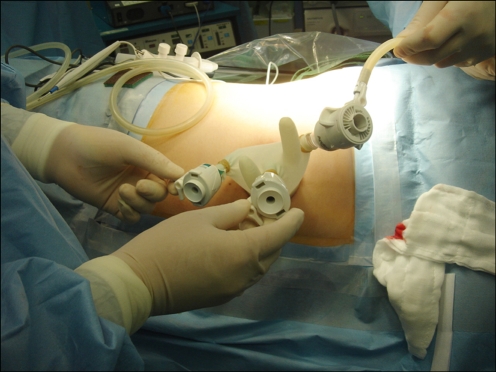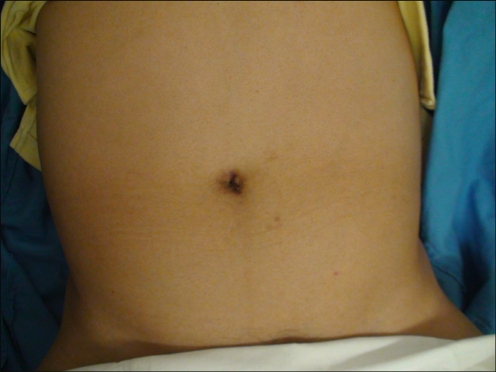Korean J Urol.
2010 Jun;51(6):403-408.
Transumbilical Laparoendoscopic Single-Site Ureterolithotomy for Large Impacted Ureteral Stones: Initial Experiences
- Affiliations
-
- 1Department of Urology, Samsung Medical Center, Sungkyunkwan University School of Medicine, Seoul, Korea. deokhyun.han@samsung.com
Abstract
- PURPOSE
We presented our initial clinical experiences with transumbilical laparoendoscopic single-site (LESS) ureterolithotomy for large, impacted ureteral stones.
MATERIALS AND METHODS
Between March 2009 and November 2009, seven LESS ureterolithotomies were performed at our institute. During the operation, we made a single 2 cm incision at the umbilicus and a homemade port by using a small wound retractor (Alexis(R), Applied Medical, Rancho Santa Margarita, USA), a surgical glove, and conventional trocars. The operation was performed in the same manner as conventional laparoscopic surgery. The mean maximal stone diameter was 21.9 mm (range, 16.0-27.0 mm). There were six cases of upper ureteral stones and one case of a mid-ureteral stone. Perioperative and postoperative parameters were evaluated.
RESULTS
The mean operative time was 197.1 min (range, 150-270 min). No transfusions were required. The mean postoperative hospital stay was 3.3 days (range, 2-6 days). The mean pain intensity on a visual analogue scale (VAS) on postoperative day 2 was 26 mm (range, 0-80 mm), and the mean cosmetic VAS at 6 weeks after the operation was 0 mm. The mean time for patients to return to their baseline activities was 4.0 days (range, 3-7 days). In six cases, all stones were completely removed on the basis of postoperative radiologic evaluation. There were no cases of major complications, including internal organ injury, urinary leakage, or urinary tract infection.
CONCLUSIONS
Transumbilical LESS ureterolithotomy can be considered as an alternative treatment option with minimal invasiveness and good effectiveness for large, impacted ureteral stones.
MeSH Terms
Figure
Reference
-
1. Segura JW, Preminger GM, Assimos DG, Dretler SP, Kahn RI, Lingeman JE, et al. Ureteral Stones Clinical Guidelines Panel summary report on the management of ureteral calculi. The American Urological Association. J Urol. 1997; 158:1915–1921. PMID: 9334635.2. Preminger GM, Tiselius HG, Assimos DG, Alken P, Buck C, Gallucci M, et al. 2007 guideline for the management of ureteral calculi. J Urol. 2007; 178:2418–2434. PMID: 17993340.
Article3. Skrepetis K, Doumas K, Siafakas I, Lykourinas M. Laparoscopic versus open ureterolithotomy. A comparative study. Eur Urol. 2001; 40:32–36. PMID: 11528174.4. Goel A, Hemal AK. Upper and mid-ureteric stones: a prospective unrandomized comparison of retroperitoneoscopic and open ureterolithotomy. BJU Int. 2001; 88:679–682. PMID: 11890236.
Article5. Clayman RV, Kavoussi LR, Figenshau RS, Chandhoke PS, Albala DM. Laparoscopic nephroureterectomy: initial clinical case report. J Laparoendosc Surg. 1991; 1:343–349. PMID: 1838941.
Article6. Gill IS, Clayman RV, McDougall EM. Advances in urological laparoscopy. J Urol. 1995; 154:1275–1294. PMID: 7658522.
Article7. Kim HH. Laparoscopic surgery in urology (I). Korean J Urol. 2003; 44:945–958.8. Desai MM, Berger AK, Brandina R, Aron M, Irwin BH, Canes D, et al. Laparoendoscopic single-site surgery: initial hundred patients. Urology. 2009; 74:805–812. PMID: 19643465.
Article9. White WM, Haber GP, Goel RK, Crouzet S, Stein RJ, Kaouk JH. Single-port urological surgery: single-center experience with the first 100 cases. Urology. 2009; 74:801–804. PMID: 19615721.
Article10. Ziaee SA, Basiri A, Nadjafi-Semnani M, Zand S, Iranpour A. Extracorporeal shock wave lithotripsy and transureteral lithotripsy in the treatment of impacted lower ureteral calculi. Urol J. 2006; 3:75–78. PMID: 17590838.11. Morgentaler A, Bridge SS, Dretler SP. Management of the impacted ureteral calculus. J Urol. 1990; 143:263–266. PMID: 1967657.
Article12. Hong TH, You YK, Lee KH. Transumbilical single-port laparoscopic cholecystectomy: scarless cholecystectomy. Surg Endosc. 2009; 23:1393–1397. PMID: 19118436.13. Paik ML, Wainstein MA, Spirnak JP, Hampel N, Resnick MI. Current indications for open stone surgery in the treatment of renal and ureteral calculi. J Urol. 1998; 159:374–378. PMID: 9649242.
Article14. Dretler SP, Keating MA, Riley J. An algorithm for the management of ureteral calculi. J Urol. 1986; 136:1190–1193. PMID: 3773088.
Article15. Sinha M, Kekre NS, Chacko KN, Devasia A, Lionel G, Pandey AP, et al. Does failure to visualize the ureter distal to an impacted calculus constitute an impediment to successful lithotripsy? J Endourol. 2004; 18:431–435. PMID: 15253812.
Article16. Roberts WW, Cadeddu JA, Micali S, Kavoussi LR, Moore RG. Ureteral stricture formation after removal of impacted calculi. J Urol. 1998; 159:723–726. PMID: 9474134.
Article17. Mugiya S, Nagata M, Un-No T, Takayama T, Suzuki K, Fujita K. Endoscopic management of impacted ureteral stones using a small caliber ureteroscope and a laser lithotriptor. J Urol. 2000; 164:329–331. PMID: 10893577.
Article18. Michel MS, Trojan L, Rassweiler JJ. Complications in percutaneous nephrolithotomy. Eur Urol. 2007; 51:899–906. PMID: 17095141.
Article19. El-Moula MG, Abdallah A, El-Anany F, Abdelsalam Y, Abolyosr A, Abdelhameed D, et al. Laparoscopic ureterolithotomy: our experience with 74 cases. Int J Urol. 2008; 15:593–597. PMID: 18479354.
Article20. Raboy A, Ferzli GS, Ioffreda R, Albert PS. Laparoscopic ureterolithotomy. Urology. 1992; 39:223–225. PMID: 1532102.
Article21. Gaur DD. Laparoscopic operative retroperitoneoscopy: use of a new device. J Urol. 1992; 148:1137–1139. PMID: 1404623.
Article22. Jeong BC, Park HK, Byeon SS, Kim HH. Retroperitoneal laparoscopic ureterolithotomy for upper ureter stones. J Korean Med Sci. 2006; 21:441–444. PMID: 16778386.
Article23. Nouira Y, Kallel Y, Binous MY, Dahmoul H, Horchani A. Laparoscopic retroperitoneal ureterolithotomy: initial experience and review of literature. J Endourol. 2004; 18:557–561. PMID: 15333221.
Article24. Kaouk JH, Haber GP, Goel RK, Desai MM, Aron M, Rackley RR, et al. Single-port laparoscopic surgery in urology: initial experience. Urology. 2008; 71:3–6. PMID: 18242353.
Article25. Raman JD, Cadeddu JA, Rao P, Rane A. Single-incision laparoscopic surgery: initial urological experience and comparison with natural-orifice transluminal endoscopic surgery. BJU Int. 2008; 101:1493–1496. PMID: 18325059.
Article26. Jeong W, Jeon HG, Yu HS, Kim KH, Yang SC, Rha KH, et al. Embryonic-natural orifice transluminal endoscopic surgery nephrectomy. Korean J Urol. 2009; 50:609–612.
Article27. Rane A, Rao P, Rao P. Single-port-access nephrectomy and other laparoscopic urologic procedures using a novel laparoscopic port (R-port). Urology. 2008; 72:260–263. PMID: 18468664.
Article28. Soble JJ, Gill IS. Needlescopic urology: incorporating 2-mm instruments in laparoscopic surgery. Urology. 1998; 52:187–194. PMID: 9697780.
Article
- Full Text Links
- Actions
-
Cited
- CITED
-
- Close
- Share
- Similar articles
-
- Laparoscopic Ureterolithotomy has a Role for Treating Ureteral Stones
- The Risk Factors of Ureteral Stricture after Treatment for Ureteral Calculi
- Laparoscopic Retroperitoneal Ureterolithotomy
- Hybrid laparoscopic myomectomy: A novel technique
- Efficacy of Laparoscopic Ureterolithotomy for the Upper Ureter Stone





